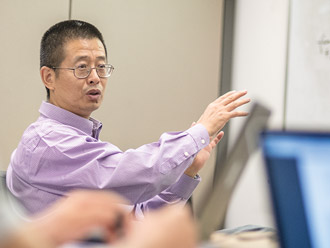When civil war broke out in his home country of Libya, Maher Abujelala was an undergraduate student studying computer science in Washington. He soon began hearing reports of his fellow Libyans losing limbs or becoming paralyzed in battle.
“It was then that I started becoming interested in the health care applications of my field of study,” he says. “I wanted to find a way to contribute to my society through education, so I sought graduate programs that would allow me to bridge computer science with health care.”
He found what he was looking for at The University of Texas at Arlington. Now a fourth-year Ph.D. student in Professor Fillia Makedon’s Heracleia Human-Centered Computer Laboratory, Abujelala is working on projects in smart-robot based rehabilitation, building cognitive and physiological assessment systems, and experimenting with advanced simulations using sensor technologies.
“The general idea of my research is to monitor and assess human activities and performance and utilize technologies to enhance quality of life,” he explains. “When I graduate, I will go back to my home country, where I will work hard to leverage the knowledge I gained at UTA and adapt it to the postwar needs of my society.”
In broad terms, Abujelala’s research falls under the category of human performance research, a multidisciplinary field that looks at any task-centered action humans perform and considers how it could be improved. He is one of a number of researchers at the University who are taking a closer look at human performance along the lifespan—using their different perspectives to design new methods, systems, and insights that may lead to a healthier and happier future for us all.
Starting Strong
In a gym on UTA’s campus, children ranging in ages from 4 to 16 are working on rewiring their brains. Not that they know that. The students are grouped in clusters, working on a variety of activities. Some are cutting shapes from paper. Some are navigating a simple obstacle course. Others are bouncing balloons. All are having a great time.
These students are part of Priscila Caçola’s Little Mavs Movement Academy, a free group motor skill intervention program for children with movement and coordination difficulties. The activities are designed to help them improve both fine and gross motor skills, focusing specifically on body coordination, balance, and manual dexterity.
“These are kids who have a hard time with basic motor function, like writing or tying their shoes,” says Dr. Caçola, associate professor in the Department of Kinesiology. “They lack certain baseline skills that we often take for granted.”
Priscila Caçola (left) with Cheryl Anderson, associate professor emeritus of nursing.
Now in its sixth year, Little Mavs has helped hundreds of kids not only improve their motor function, but also build confidence and self-esteem as they work alongside peers who have similar difficulties.
Little Mavs is housed in Caçola’s Developmental Motor Cognition Laboratory, which primarily focuses on investigating the development of motor behavior in children and adolescents. The lab explores screening and diagnostic tools related to motor coordination disorders in children and proposes intervention, training, and rehabilitation protocols.
“Our ultimate goal is to understand motor development and how it progresses across the lifespan,” she says. “We look specifically at the cognitive aspect of movement—what happens when our planning and feedback abilities are compromised? And how can we improve that?”
Answering those questions is paramount to helping these kids grow both physically and mentally so they can thrive later in life.
“The human condition is all about performance, and especially motor performance,” says Caçola. “It’s the beginning of everything. If you don’t have the ability to perform and move optimally, it limits your ability to interact with the world. UTA is taking a preventative approach—not just at my lab, but across disciplines.”
Working Smarter
Increasingly, interacting with the world as a human means working with computers and artificial intelligence (AI) in all their iterations. In Dr. Makedon’s Heracleia Human-Centered Computer Laboratory, researchers are focused on this human-computer interaction, applying advanced AI methods to build task-driven human simulations to observe user behavior and assess the user’s cognitive or physical needs. The work conducted through Heracleia runs the gamut from improving the assessment of executive function in children to developing a program that enables personalized rehabilitation therapy for individuals suffering from brain injury, motor disabilities, and other cognitive impairments.
Makedon, the Jenkins-Garrett Professor in the Department of Computer Science and Engineering, is also founder and director of the National Science Foundation (NSF)-funded iPerform Center, which works with industries to develop computer-based innovations that enhance human performance at all levels. In turn, this leads to better productivity and increased safety and worker retention.
In late 2017, Makedon earned a $999,638 NSF grant to develop iWork, a smart, robot-based service system that assesses workers’ physical, cognitive, and collaborative skills while they perform manufacturing tasks in a simulated, lab-controlled setting. The ultimate goal is to discover the best way to prepare workers for the industry of the future, where employees will need to safely and efficiently collaborate with advanced robots.
“Humans are driven to seek higher levels of performance, period.”
“Things have changed in the workplace, particularly in production,” she notes. “Robots used to be kept in separate physical spaces, but now humans must work alongside them.”
The interdisciplinary team collaborating on iWork includes computer science and engineering Associate Professor Vassilis Athitsos and Morris Bell, a psychology expert from Yale University.
“iWork will assess and train both human and robot co-workers, producing personalized, low-cost vocational training solutions that have huge economic and societal impacts,” Makedon says. “It could also impact millions of people seeking to retrain for a manufacturing job, including those facing a type of learning or aging disability or returning from military service with health issues.”
Heart Healthy
When Mark Haykowsky, professor and Moritz Chair in Geriatrics in the College of Nursing and Health Innovation (CONHI), measures human performance, he generally looks at matters of the heart—its size, shape, and how well it delivers oxygen to the rest of the body. Specifically, he’s focused on “oxygen uptake,” or the body’s oxygen consumption in ml/kilogram/min per body weight.
“When we measure oxygen uptake, we’re looking at the peak oxygen uptake required for independent living,” he explains. “My research program examines the biological mechanisms for the decline in health-related fitness in individuals at risk for or with heart failure and the role of exercise training to restore cardiovascular and skeletal muscle function.”
Together with a team of CONHI researchers, he is using a $308,000 grant from the National Institutes of Health to study the mechanisms and management of exercise intolerance in older heart failure patients with preserved ejection fraction (HFpEF), the fastest-growing type of heart failure. The mortality rate for these patients is high, and the primary symptoms they suffer are fatigue and exercise intolerance. In extreme cases, patients may not have the energy for even the most basic physical functions.
Mark Haykowsky with a FitSTEPS participant.
“Like climbing a flight of stairs,” Dr. Haykowsky says. “It’s hard for healthy individuals to fathom, but when the oxygen cascade—the delivery of oxygen from outside air to the body’s systems—is compromised, it can be a challenge to complete even the simplest tasks of daily living.”
Haykowsky, who directs the Integrated Cardiovascular and Exercise Physiology and Rehabilitation Laboratory, also oversees the FitSTEPS for Life Cancer Rehabilitation program. FitSTEPS is a free, community-based nutrition and exercise program designed to help cancer patients increase mobility and boost endurance while undergoing treatment.
Programs like FitSTEPS are especially important for older breast cancer patients, for whom a leading cause of mortality is cardiovascular disease. The best intervention, Haykowsky says, is exercise.
“Breast cancer patients tend to have very low fitness—to the extent that, for some individuals, performing the activities of daily living can become quite difficult. However, studies show that exercise is an effective intervention to attenuate the decline in fitness that occurs during chemotherapy.”
Brain Games
While Haykowsky and other CONHI researchers are looking at heart function, George Kondraske, an electrical engineering and bioengineering professor, has developed a framework for computer tests and games that track brain performance.
His General System Performance Theory (GSPT) allows users to measure different aspects of the brain. In this systems approach, a human can be viewed as a set of subsystems, each of which possesses different types of performance resources.
“GSPT tells us how to develop the performance measures,” says Dr. Kondraske. “It allows us to make tasks that are target-specific so we get an accurate picture of where people’s brain performance capacities are using unifying standards and test methods.”
GSPT was used to develop two web- and mobile app-based tools—RC21X and the Roberto app—that empower users to monitor their brain performance. Kondraske is chief architect of both. UTA and Home Base Impairment Co. Inc., the parent company that provides the tools, signed a licensing agreement to use GSPT in these and similar applications. Users include medical and academic researchers, professional athletes, insurance companies, and individuals suffering from brain diseases like Alzheimer’s.
“The idea is to bring the whole picture into view so we can put everyone on the same spectrum of human performance,” says Kondraske. “It doesn’t matter where you are on the spectrum; it matters what performance resources you have available.”
He believes that human performance lives at the heart of health and the human condition.
“It cuts across the whole spectrum of the human individual, including those who have less than the average amounts of human performance resources. Humans are driven to seek higher levels of performance, period.


